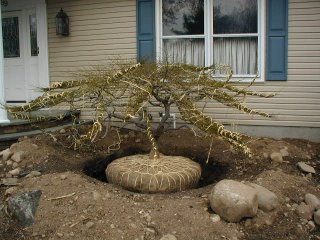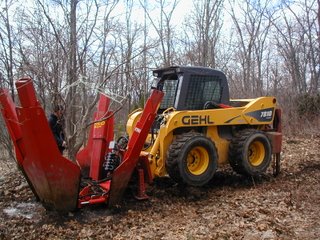As I may have mentioned in past posts, a large percentage of the projects I’m involved with are renovations. This would include correcting improperly done work as well as redoing older work that has simply “served its time”.
Older landscapes often have larger plant material that’s in relatively good condition and can be utilized in the redesign & renovation. Newer landscapes that were poorly designed and/or arranged can literally be “disassembled” quite easily and redone.
Today we still practice the conventional method of transplanting called “balled & burlap,” which you can see in the photo below. In some circumstances it is the only option you may have.

However, when the transplanting situation can accommodate a larger piece of equipment, you can accomplish the task in much less time and often at a lower cost using specialized equipment.
In this next picture you see a mechanical tree spade mounted on a skid steer machine. This particular tree spade can make a root ball up to 52″ in diameter. This could mean moving a tree that’s up to 18′ tall.
Here are some of the advantages to transplanting larger plants on these renovation projects.
- We can establish (or preserve) a substantial scale in the design or create an impressive privacy screen.
- It would normally be more costly to supply and install new plants this size than the cost of transplanting.

Yes there are real advantages to transplanting and using the larger plant material, but not without first considering the specific details of that particular move. Every transplant is different and comes with its own set of circumstances.
Once you’ve listed and realized all the logistical factors, it will be clearer to you as to whether transplanting is the right decision. It often comes down to a cost : value factor, i.e. “Is the cost worth the risk and the “real value” of the plant?
From experience you should be able to estimate the potential (or percentage) of success. You should also know the approximate cost of supplying and installing a new plant to compare that cost. This information will help with the decision and in your discussion with the homeowner/client.

Anonymous
What about guarantees?
Bill
Roger
Bill, generally there are no guarantees with transplants, but I know from experience that there are exceptions. You need to ask the company that’s doing the work. Realize that if they decide to offer a guarantee, there will be incremental cost increases respective to the length of the guarantee.
Roger